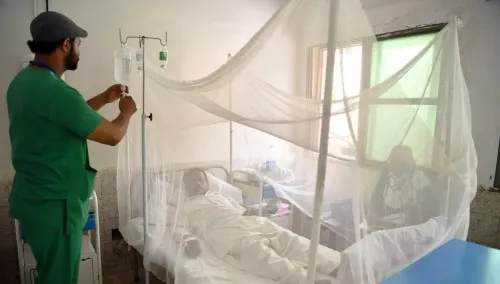What Lies Behind Myanmar’s Cybercrime Hubs and the Rescue of Indians from Chinese Mafia Control?

Synopsis
Key Takeaways
- India's IAF successfully rescued 270 individuals from a cyber slavery network in Myanmar.
- Transnational crime syndicates exploit young Indians with false job promises.
- Myanmar's Myawaddy is a key hub for organized crime linked to the Chinese mafia.
- Rescue operations are coordinated by the Ministry of External Affairs and intelligence agencies.
- India is taking proactive measures to combat human trafficking and cybercrime.
New Delhi, November 13 (NationPress) In early November 2025, two Indian Air Force (IAF) transport planes arrived at Hindon Air Base, bringing back 270 Indian citizens, among whom were 26 women. These individuals were not casualties of war or natural calamities.
They were caught in a covert battle—a global cyber slavery operation orchestrated by transnational crime syndicates, many of which have significant connections to China.
The individuals rescued were part of a larger group of hundreds ensnared in cyber scam facilities located in Myawaddy, Myanmar—an area infamous for being a hub of organized crime linked to the so-called Chinese mafia.
This recent rescue mission, organized by the Ministry of External Affairs (MEA), in collaboration with Indian embassies in Thailand and Myanmar, and executed via IAF airlifts from Chiang Mai, stands as one of India’s most advanced humanitarian and intelligence-led initiatives in recent years.
However, this successful repatriation unveils a troubling truth. In the last two years, thousands of young Indians have been misled with false promises of high-paying digital jobs in Southeast Asia, only to find themselves enslaved in compounds controlled by Chinese criminal organizations and local militias.
The victims were coerced into perpetrating online scams, cryptocurrency frauds, and romance swindles under the threat of severe punishment or death.
According to open-source intelligence, between January 2022 and May 2024, over 29,466 Indians traveled to Cambodia, Thailand, Myanmar, and Vietnam on tourist visas and did not return.
Many are believed to have fallen victim to similar cyber slavery networks, creating a growing digital underground fueled by desperation and deceit.
The Chinese Mafia’s Shadow Empire
The criminal networks behind these scams extend from Cambodia’s Sihanoukville to Laos’ Golden Triangle and Myanmar’s Myawaddy—regions that have transformed into the dark nerve centers of Southeast Asia’s shadowy digital economy.
At the heart of this is a Chinese mafia network consisting of rogue business figures, triad-connected investors, and organized cybercrime factions.
These groups exploit lawless border territories and ineffective governance to create fortified scam compounds—complete with armed guards, surveillance apparatus, and private militias. The notorious KK Park and Shwe Kokko complexes in Myanmar, where many Indians were detained, are among the most infamous.
While these facilities claim to be “tech parks” or “investment zones,” intelligence reports and satellite imagery have revealed their true nature as cybercrime centers run by Chinese syndicates under the protection of local rebels.
The scam operations are highly organized. Victims are compelled to engage in “pig-butchering” scams—long-term online frauds that blend romance, cryptocurrency, and investment traps targeting victims in the U.S., Europe, and India.
Those who fail to achieve their targets are subjected to beatings, starvation, or sold to other compounds for a higher “price.”
Accounts from rescued Indians illustrate the brutal reality of this system. Satish, a restaurant manager from Maharashtra, was enticed online with a “digital marketing job” in Thailand. Once he arrived in Myawaddy, his passport was confiscated, and he faced physical punishment for minor errors.
“We were sold for $5,000,” he recounted to officials after being rescued. “We were beaten if we refused to comply, punished if we slowed down. They claimed the camp was owned by Chinese people.”
Similarly, Pradeep Vijay, a 24-year-old from Maharashtra, spent nearly a year trapped in a Chinese-run cyber compound. His family ultimately paid ₹10 lakh in ransom for his release after enduring months of silence and dread.
These narratives highlight the alarming reach of China-linked syndicates that now operate a modern slave economy—driven not by plantations or factories, but by laptops and stolen identities.
A Diplomatic Triumph Amid Chaos
India’s rescue mission in November is a significant achievement in this murky geopolitical landscape. Following Myanmar’s military operations in late October to regain control over Myawaddy, chaos ensued.
Numerous scam operators—mostly Chinese nationals—fled, leaving their compounds behind. In the ensuing confusion, hundreds of captive workers, including Indians, managed to escape across the Moei River into Thailand’s Mae Sot region.
Indian diplomatic teams in Bangkok and Yangon immediately mobilized. Collaborating with Thai police, Interpol, and Myanmar authorities, they identified and confirmed the stranded victims. Two IAF aircraft were dispatched to Chiang Mai to bring the rescued Indians back home to Hindon Air Base.
This was not India’s first operation in this regard. Earlier in 2025, the MEA coordinated similar rescues—549 Indians were saved in March, over 60 in April, and now 270 in November.
Each mission necessitated careful negotiations with multiple governments and intelligence coordination to track victims’ digital footprints across territories ruled by warlords and militias.
The MEA’s Crisis Management Cell, supported by cyber intelligence agencies, worked tirelessly to map recruitment networks, locate compounds, and facilitate repatriation.
Indian officials acknowledge that this mission required extensive back-channel discussions with Thai and Myanmar counterparts—especially in areas where official law enforcement is virtually non-existent, and local armed factions operate with implicit Chinese support.
India’s Strategic Response to a Transnational Threat
The Indian government’s response to this crisis has been clear and strategic: safeguard citizens, dismantle trafficking networks, and foster deterrence through diplomacy and awareness.
Those rescued from the Myawaddy cyber hubs are currently undergoing debriefing by Indian authorities. Officials have emphasized that this process is not punitive but preventive—aimed at revealing recruitment pathways, identifying Indian accomplices, and exposing the operational frameworks of these criminal syndicates.
“We want to understand how this all began,” a senior MEA source informed The Hindu. “Our objective is to sever the chain that facilitates such crimes, not to penalize the victims.”
The Indian Embassy in Bangkok has subsequently issued a stern advisory urging citizens to be cautious of dubious overseas job offers and reminding travelers that tourist visas are not intended for employment. Yet, despite multiple advisories, young Indians continue to be enticed by fraudulent recruitment advertisements promising attractive salaries and opportunities abroad.
Thai Prime Minister Anutin Charnvirakul recently revealed that approximately 500 Indian nationals were stranded in Thailand after escaping Myawaddy. He identified the KK Cyber Hub as a key node of global online fraud, labeling it a “threat to Thailand’s national credibility.”
For India, this issue transcends mere humanitarian concern—it poses a national security threat. The same networks that traffic Indian workers are deeply involved in global cybercrime, cryptocurrency fraud, and money laundering schemes that could destabilize economies.
Beyond Rescue: A Battle for the Digital Frontier
Operation Myawaddy has reaffirmed India’s growing capacity to exert humanitarian and strategic influence beyond its borders.
The collaboration between the MEA, the IAF, and India’s intelligence agencies illustrates a state apparatus that is increasingly proficient in managing complex, transnational crises.
However, the larger battle is far from over. The rise of cyber slavery—propelled by Chinese mafia syndicates, transnational cartels, and local militias—presents a new type of global peril. It thrives in the blurred lines of digital anonymity and geopolitical instability, where borders are insignificant, and human lives are disposable.
India’s success in rescuing its citizens from these cyber gulags sends a potent message: the state will not forsake its people, no matter how deeply they are ensnared in foreign criminal networks.
More importantly, it signifies India’s emergence as a responsible power willing to confront the darker aspects of globalization—where crime, technology, and exploitation intersect.
(The writer is the founder and editor of Milli Chronicle Media (UK), and serves as an analyst and geopolitical commentator, frequently appearing in Indian and international media to provide insights on the Middle East, extremism, and South Asian politics.)









